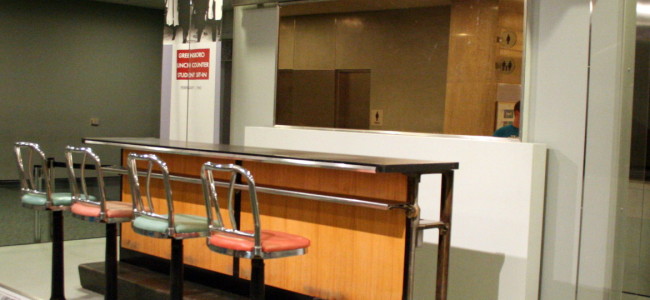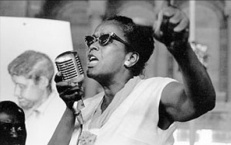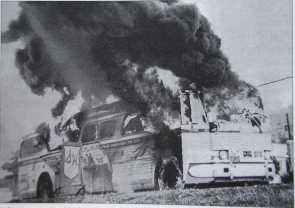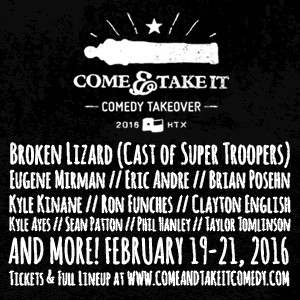By Bob Buzzanco
Featured Image by Wikimedia User: RadioFan
Fifty-Six years ago, on February 1st, 1960, four African American freshmen from North Carolina A&T University (Jibreel Khazan-ne-Ezell Blair, Jr., Franklin McCain, Joseph McNeil, David Richmond) sat down at a whites-only lunch counter at Woolworth’s in Greensboro, NC, and tried to order. They were denied service so, as planned, they decided to “sit-in” at the counter and stayed until the diner closed.
NC A&T Sit-In
(The section below is adapted from my Vietnam and the Transformation of American Life). A few days later, hundreds of A&T students held a demonstration in Greensboro and marched on the lunch counters. When white mobs asked “who do you think you are?” the A&T football team responded “we are the Union Army” and formed a wedge for the Black demonstrators to rush the counter. From such spontaneous acts of defiance emerged one of the largest protest campaigns in American history. Word of the initial Greensboro action, termed a sit-in, filtered throughout black communities and students throughout the South, overwhelmingly African American but including some Whites, began to do likewise.
Soon, sit-ins occurred in various cities in North Carolina, spread to Virginia and then into Tennessee, Kentucky, and Maryland. By mid-April, Black activists, especially students, had conducted sit-ins in all the southern states, with about 50,000 Blacks and Whites participating. In some cases, White onlookers physically assaulted Blacks sitting at lunch counters, and even when they did not, they verbally attacked and threatened them. Still, the students, in line with King’s philosophy, renounced violence and their approach started to turn heads. Even James Kilpatrick, an ardent segregationist columnist in Richmond, wrote about the contrast between the “colored students in coats, white shirts, and ties” and the white hecklers–a “ragtail rabble, slack-jawed, black-jacketed, grinning fit to kill” and waving the Confederate flag.
Despite their appearance and demeanor, the students had a hard time getting mainstream support. Many northern liberals and national Black organizations like the NAACP feared that the sit-ins were too militant and could provoke an even greater attack on southern Blacks. King and his organization, the Southern Christian Leadership Conference [SCLC], thought otherwise. They threw their support and resources behind the sit-ins, helping to coordinate them and raise bail for those demonstrators, nearly 4000, arrested for trying to desegregate lunch counters.
Most importantly, an SCLC officer, Ella Baker, organized a conference of young Black activists that would give rise to the most important protest group in the Civil Rights [CR] era, the Student Nonviolent Coordinating Committee [SNCC, or “Snick”]. Baker was one of the pivotal figures in the era, yet remains relatively underappreciated. Out of SNCC would come many of the leaders of the African American struggle in the 1960s, including John Lewis, Diane Nash, Julian Bond, James Lawson, Marion Barry, and many others. SNCC would take a different approach to CR than older, established groups. Powerfully-spoken and confrontational, SNCC activists would have a hand in all the major actions of the decade. SNCC members became the prime target of southern hatred and violence but, to other young activists across the country they held a special place. Tom Hayden of SDS believed that SNCC activists “lived on a fuller level of feeling . . . because by risking death they came to know the value of living each moment to the fullest . . . I wanted to live like them.”
Ella Baker Speaks!
As Black leaders and White liberals feared backlash, Baker and King remained dedicated to aggressive nonviolence. MLK continued to back the movement and agreed to join a protest in Atlanta in mid-October. Arrested, King and 36 others chose “jail, not bail” in line with their Gandhian principles of civil disobedience–willfully breaking unjust laws and accepting the consequences. While waiting trial, the Reverend received a sentence of four months of hard labor for violating the terms of an earlier arrest for a traffic offense. His wife, Coretta, six months pregnant, contacted an old friend and member of JFK’s campaign staff, Harris Wofford, and worried, “they are going to kill him, I know they are going to kill him”–a fate not uncommon to jailed blacks in the South.
Immediately, Kennedy called Mrs. King to express his concern and his brother Bobby used the family’s connections to arrange bond for MLK and get him released from jail. That Sunday, King’s father, “Daddy King,” one of the better-known ministers in the South, and scores of other African-American clergy endorsed Kennedy for president during their sermons. Up to the point the Republican candidate, Richard Nixon, was enjoying fairly large Black support, but Kennedy eventually received over 75 percent of the African American vote, an important amount in a close victory over Nixon.
King was grateful and optimistic that he could work with JFK and envisioned a relationship with the president like Frederick Douglass had with Abraham Lincoln during the Civil War, serving as a moral voice to pressure national action on race issues. Like Douglass, King would face challenges at every step along the way. JFK was hardly on board.
While the Kennedy administration would offer some support to CR, it also valued traditional southern support and did not want to alienate loyal Democratic segregationists, so JFK’s behavior on racial issues would be ambivalent and tentative at best. African Americans generally were enthused by Kennedy’s victory and the new president made symbolic overtures to the Black community as well; many of the same Hollywood celebrities that had celebrated JFK’s inaugural–including Frank Sinatra, Sammy Davis, Count Basie, Dean Martin, Tony Bennett, Nipsey Russell, and others–had a gala fundraiser for King a week afterwards and raised over $50,000 for the SCLC.
During the first CR crisis of his presidency, however, Kennedy wavered. In the summer of 1961 the national director of the Congress On Racial Equality [CORE], James Farmer, organized a series offreedom rides. The rides involved a challenge to laws that segregated interstate travel by having Black and White activists travel by bus throughout the south.
CORE’s approach was admittedly confrontational. “Our intention,” Farmer explained, “was to provoke the Southern authorities into arresting us and thereby prod the Justice Department into enforcing the laws of the land.” Rather than arrest the riders, however, authorities in South Carolina and Alabama simply looked the other way as White mobs attacked and beat the CORE members.
The original riders, battered and injured, then flew to New Orleans, but SNCC activists, led byJohn Lewis, traveled to Montgomery to resume the rides. They too were immediately savaged as they stepped off their bus. No police were in sight as the White mob grew to nearly a thousand. Finally, after three weeks of wavering, Attorney General Robert Kennedy sent 400 marshalls to Montgomery to protect the riders, but also called on CORE and SNCC to end the rides and “cool off.” They refused, with Farmer explaining that blacks “had been cooling off for a hundred years. If we got any cooler, we’d be in a deep freeze.”
So the rides continued.
Freedom Riders Attacked
Over 1000 Americans–northern and southern, Black and White–participated, over 300 were arrested, and countless others were intimidated and attacked. Their sacrifice finally paid off, though. In late 1961, the Interstate Commerce Commission banned segregation in interstate travel and most southern communities began to comply with the laws in 1962. If Whites could be provoked into violent responses to CR demonstrations, the freedom riders proved, then the media would report on it and politicians would have to act.
That scenario would only become more common as the struggle continued. Indeed, Blacks continued to defy authority and fill jails in 1962. In Albany, Georgia, the main theater that year, one out of twenty African Americans spent time behind bars, much to the satisfaction of Police Sheriff Laurie Pritchett, who was fond of saying that he followed a policy of “mind over matter” because Whites “didn’t mind” and Blacks “didn’t matter.” Southern governors such as Ross Barnett of Mississippi and George Wallace of Alabama believed likewise, and made defiant public stands against the admission of Black students into state universities.
Racist southerners, however, were not the movement’s only enemies at the time. Northern liberals, as the mixed Kennedy response to the freedom rides had shown, were wary of the confrontational nature of the CR actions in 1961-1962. The Department of Justice did little to investigate the myriad cases of police brutality and lynchings against Blacks, while the FBI did less because it was afraid of being seen as “a crusader on civil rights.” Other liberals redbaited the movement, claiming that it had been infiltrated and taken over by subversives. Militants, the liberal journalist James Wechsler wrote, were “staging an uprising against the major civil rights blocs . . . encouraged by a fragment of Communists.”
Anti-Communism, again, was the last refuge of Liberals.
From that point on, the tactics of the sit-in movement continued. Non-Violent Direct Action [NVDA] was constantly being practiced against the infrastructure of southern apartheid–in boycotts, in sit-ins, large-scale marches and demonstrations, and in major campaigns like Freedom Summer. Finally, in 1964 and 1965, Congress passed the Civil Rights Act and Voting Rights Act, dismantling the system of legal segregation in the South. Ella Baker, King, SNCC, and so many others had accomplished their first goal.
After that, however, the struggle of Blacks, of all poor people, for justice was thwarted. Northern liberals were satisfied that the legal remedies they had put in place were enough to overcome centuries of violent racism and Jim Crow. “Black Power” terrified liberals and almost all Whites;when King tried to expand upon the CR Movement and create a poor people’s campaign, he was ignored and then attacked.
The legacy of the Sit-Ins can’t be understated. It was a direct and confrontational response to the harsh reality of southern apartheid. Opposed by establishment Blacks as well as White Liberals [and of course southern segregationists], the sit-in participants didn’t waver, and literally put their lives at risk to demand civil and human rights. King and the CR Movement often were called practitioners of “passive resistance” by liberals and some Black activists, but that’s not the most accurate description.
As King described it, he believed in militant nonviolence, nonviolent resistance, or even provocation. The point was to highlight the horrors of Jim Crow by confronting the representatives of the southern apartheid system at the point of action–with boycotts, sit-ins, bus rides, marches, voting drives, and so forth. In that way, they would force a strong reaction which, when observed nationally via media and first-person accounts, would cause a huge counter-reaction by economic and political elites and the general population in the North. And then, the outrage would be so great that those segments would act, as they did with the 1964 and 1965 laws. It was not passive, but in fact direct and militant, albeit nonviolent, resistance against southern racism.
Those kinds of tactics were not brand new in February, 1960. Indentured servants, slaves, working people, women, and other groups that had been repressed and marginalized had used aggressive means before, but the sit-in movement caught the attention of politicians and media in new and more significant ways, as the struggle against the historical oppression of African Americans from 17th-century slavery forward demanded new energy and tactics.
Since then, the tactics of sit-in and other forms of NVDA have been used by various groups, but with diminishing returns. Today, while aggressive actions are still used–especially with regard to activism on the issues of poverty and environmental degradation–many protesters are “keyboard activists,” preferring twitter, Facebook, and social media to going into the streets.
Scott Parkin, a long-term activist with environmental organizations Rainforest Action Network and Rising Tide North America, has organized campaigns on the issues of mountaintop coal removal, fracking, and the Keystone XL Pipeline, and he talks about the historical lessons of the CR era, how they have been used, successes, and the failures and pitfalls of some of today’s activism:
Non-violent civil disobedience used during the civil rights era was an effective tool to create a crisis around segregation. With non-violence the strategy, and direct intervention in the existing political system as the philosophy, today’s environmental and social justice movements have attempted to emulate the civil rights movement’s successes. But the goals are often compromised away by larger institutional adherence to liberal Democratic politics and maintaining the status quo, as well as an emphasis on “clicktivism” to somehow fight the system on email and Facebook alike at a time.
Historical comparisons are popular, but generally facile. In this case, the objective conditions for southern Blacks in February, 1960 derived from a unique historical legacy and specific relations with an oppressive White ruling class. So we can’t simply transplant the tactics and campaigns of the sit-in era into contemporary political issues.
Yet we can learn that an aggressive, at times provocative, resistance was central to the sit-in and larger CR campaigns, and still has value today. Surely it offers more than “hashtag activism” or going all-in on a quixotic campaign for a so-called socialist running for president and calling it a“movement” or, even more, a “revolution.” Indeed, many of the tactics and priorities of activists today are the very antithesis of the types of grass-roots organizing and direct action that self-described leftists have long tended to advocate and praise, and which do have a historical record of some effectiveness. Sit-ins were essential to longer-term progress and movement building in ways that a quadrennial infatuation with a new political crush could never approach.
Ella Baker and the activists in SNCC didn’t jump on the bandwagon for a presidential candidate; they confronted the system at the point of oppression in a direct and assertive manner. When Stokely Carmichael saw the images of the students sitting in, he was “burning” and took to the streets; today, self-described radicals, often unwittingly elitist themselves, are “Berning” and take to Twitter. The outcome is predictable . . .
Bob Buzzanco is a historian and activist who has written dozens of books and articles on foreign policy, the Vietnam War, the economy, American protest, and other topics. He writes at afflictthecomfortable.org and he can be reached at Twitter at @BobBuzzanco.












